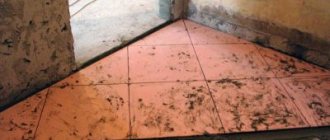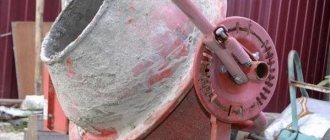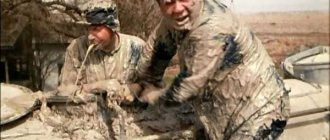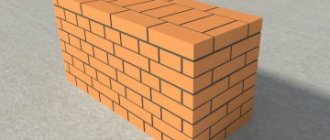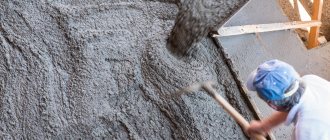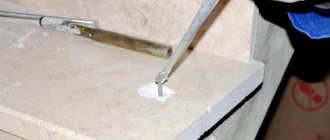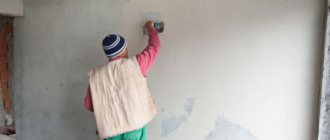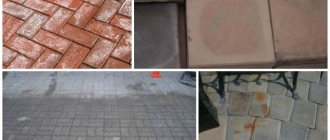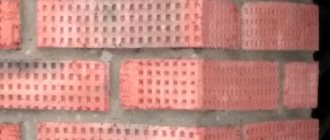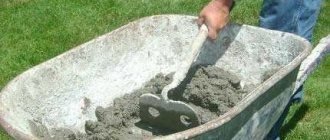Each of us at least once in our lives has faced the problem of cleaning brickwork from cement mortar. This situation could arise if it was necessary to use used bricks to build new walls, or the builders “tried their best” by leaving a large amount of cement cakes on the walls. In this case, you need to clean the brick or masonry from any remaining dry mortar. This problem can be solved in different ways. We will tell you the rules that will help you do this job efficiently.
The processing of each type of brick is individual. For example, sand-lime brick cannot withstand exposure to aggressive chemical environments, so the use of hydrochloric and sulfuric acids for its cleaning is unacceptable. If you decide to experiment, be aware: this treatment will simply cause the material to crumble.
Solvent cleaning
If you don’t have time to clean the brickwork mechanically, then you can choose a more simplified option using special means. Construction stores offer a fairly large selection of acid-based chemicals. The product applied to the wall will destroy the structure of the hardened mortar, which will make it easy to clean it manually. If silicate brick was used to lay the wall of the house, then acid cannot be used, as it will damage it, but for a ceramic type, this is the most suitable option.
Initially, you need to familiarize yourself with the range of these products, instructions, technology for carrying out work, as well as advice from specialists. The acid that was used to produce the product may be different, so the application and cleansing technology may differ. To save money, you can consider the option of using acid, which is used by motorists to ensure proper operation of batteries. Such products are sold in car dealerships, but before applying it to the brick, dilute it with water in a ratio of 1 to 10. After half an hour, you need to rinse everything with water so that the effect of the acid wears off.
Note! The use of acid-based solvents may result in white spots appearing on the brickwork.
When it comes to the need to remove cement mortar from facing bricks, it is worth considering more delicate options that will not damage the surface of the brick, as a result of which the wall will not lose its appearance. Facing bricks can be easily cleaned using water and special chemicals based on non-aggressive components. In most cases, specialists clean brick walls using water supplied under pressure, which is often sufficient.
To remove the solution in a small area, you can prepare your own detergent using water, soda and vinegar. If you decide to purchase the product in a specialized store, then choose from organic solvents that can easily cope not only with cement mortar, but even with soot stains on the surface.
Note! When choosing a means to clean a wall made of facing bricks, you should not use chlorine, because it will ruin the masonry.
Regardless of which cleaning option is chosen to remove grout from masonry, a final step is required. To ensure that the result is secured, experts recommend using a water repellent, which will not interfere with air circulation in the walls, but will also create a protective layer from moisture.
How to clean soot from cement
During the operation of a building with brickwork, soot may appear on it. You need to get rid of it as early as possible, otherwise it will be much more difficult to remove the soot later.
Before starting work you must:
- Cover the floor with film so that soot does not settle on it.
- Take detergent and tools for work.
- Clean the wall.
Any detergent (for example, powder) is suitable as a detergent. The main thing is that it foams well. A soap solution is diluted in a basin. After this, a sponge is dipped in soapy water and the cleaning of the brick begins.
You need to start from the top corner, then gradually move down. The surface should be slightly moistened and leave soap foam. After a few minutes, this foam along with the soot can be easily removed using a clean cloth.
After applying a soap solution with thick foam to the wall, you need to wait a while. If after a few minutes the foam turns black, then this product has begun to act and the solution can be washed off.
In addition to soap, you can use regular table vinegar. To do this, it is diluted in water in a 1:1 ratio. After this, the solution is applied to the wall, and after a few minutes the wall is cleaned with a wire brush.
There are special soot removers that are sold at any hardware store. They remove dirt more effectively and quickly, but this option is more expensive.
Video
This video shows how you can clean brick from not very hardened and completely dried mortar:
When carrying out construction work, in order to save money, they very often use bricks that were once in the brickwork, so before starting work, you will need to clean the bricks from the mortar.
The cost of such work carried out by specialists is quite high, for example, the average price for cleaned 1 m² will be 150 rubles. Therefore, it is better to organize it yourself.
There are plenty of ways to remove cement. A mechanical method or a chemical one can be used, which is based on means for cleaning bricks from mortar, industrially or independently produced.
In addition to old mortar, contaminants formed on brickwork can be of a completely different nature, for example, mold, soot, and the appearance of salts. Therefore, work on cleaning such bricks requires an individual approach.
We’ll tell you how to do it correctly in our article.
Advice from professionals
For high-quality cleaning of bricks, you can use the advice of professionals:
- When cleaning from cement mortar, the brick can be moistened with water. The cement will absorb a small amount of moisture and come off easily.
- The chemical method of cleaning bricks from mortar is carried out only for red ceramic bricks.
- When using various chemical solutions to clean brick, you need to wear gloves and protective clothing. It is advisable to cover the floor with film.
- Before cleaning brick, it is best to do a test cleaning on a small area. This will help ensure that the product will not damage the surface of the material.
Removing plaque from brick using improvised means is quite simple. To speed up the work, you can purchase the solution in the store. The main thing is to follow the instructions for carrying out the work. Due to this, you can get a high-quality result.
When carrying out construction work, in order to save money, they very often use bricks that were once in the brickwork, so before starting work, you will need to clean the bricks from the mortar.
brick cleaning technique
The cost of such work carried out by specialists is quite high, for example, the average price for cleaned 1 m² will be 150 rubles. Therefore, it is better to organize it yourself.
In addition to old mortar, contaminants formed on brickwork can be of a completely different nature, for example, mold, soot, and the appearance of salts. Therefore, work on cleaning such bricks requires an individual approach.
Why does pollution occur?
Due to the high porosity of the material, this building material is easily contaminated, therefore, to maintain its aesthetic appearance, periodic cleaning of contaminants is necessary. In addition to excess mortar that needs to be cleaned, the brick can become stained, dirty, and efflorescent (salt deposits that appear as white, fuzzy spots). In order to carry out cleaning, you will need a lot of time and patience, because the work of cleaning brick is quite labor-intensive.
As practice shows, most often, already finished walls made of plain or facing bricks are removed from contamination, as well as by cleaning old bricks from mortar. The correct choice of type of cleaning depends on the type of contamination; these can be stains from lime mortar, paint, rust, stains from tar, bitumen, soot, mold and efflorescence.
The following types of contaminant removal are most often used in construction:
- washing (using a high-pressure water jet);
- mechanical removal (using a sandblaster);
- cleaning with improvised means (hammer, drill, chisel, sandpaper, stiff brush);
- removing contaminants using a chemical liquid for cleaning bricks, prepared industrially or independently.
Let's consider separately each type and means for cleaning bricks.
Removing contaminants with a high-pressure water jet
This method easily removes efflorescence formed on brickwork. Due to the high water supply pressure, which can be adjusted from 15 to 220 bar, cleaning is gentle and gentle, without damaging the wall surface, in addition to being quite effective and environmentally friendly.
Sandblasting cleaning of contaminants
This type of cleaning is carried out using a device that creates high pressure when supplying sand or other abrasive composition. When using sandblasting bricks, you can get rid of many contaminants, such as corrosion, paint stains, traces of fuel oil, bitumen, and mold. Also, cleaning bricks from plaster using a sandblaster will be quite effective.
Sandblasting requires a certain skill in operation and qualifications, this is also determined by the high cost of the work. But the result obtained is worth the money spent.
Cleansing with improvised means
This method can be classified as mechanical; it is mainly used to clean bricks from mortar and other solid contaminants. Necessary available construction materials: drill, chisel, emery, jackhammer, stiff brush, special eye protection glasses, respirator and rubber gloves.
Cleaning bricks from mortar
made by hand. Red brick is cleaned as follows: first, pieces of mortar are chopped off with a hammer or chisel, and then the surface is treated with coarse sandpaper.
Cleaning sand-lime bricks
also done using sandpaper, a drill with the necessary attachment or a jackhammer. After this, the product is moistened in water, washed from the mortar with a brush with stiff bristles and dried.
Using chemicals and liquids to remove contaminants
Depending on the type of contamination, a certain composition is used, either industrially produced or made by hand.
- Removing cement mortar
:
- Ceramic bricks are boiled in water, after first pouring sulfuric acid into it in a ratio of 1:10; this method requires some care, otherwise burns to the hands and respiratory tract are guaranteed. After a short time, it will not be difficult to clean the brick from the old mortar. But this method cannot be used to clean sand-lime brick, because it will be destroyed;
- if the contamination with the solution is small (removing excess cement from the seams of the brickwork), wipe the wall with autochemical agents, allow the product to completely absorb and dry, then wash it off with water or wipe it with a solution of brick powder and vegetable oil;
- When removing excess mortar from the wall, the bricks are wiped with diluted hydrochloric acid, and the wall is first moistened with water. When cleaning in this way, care must be taken to ensure that the acid does not corrode the cement mortar in the masonry joints.
- Cleaning brick from plaster
:
- The plaster is removed from the brick using a chisel and a hammer, after which the surface is treated with a metal brush, and the remaining plaster and dust are wiped off the surface using a wet rag.
- Removing white plaque (efflorescence)
:
- It can be removed very simply, using a metal brush and water. To ensure that the wall remains in its normal condition for as long as possible after cleaning, it is recommended to treat the wall with a water repellent after drying, which will provide a water-repellent and frost-resistant effect.
- Cleansing from other contaminants
:
- stains are removed from a painted brick wall using ordinary detergents;
- Removing contaminants in the form of stains, soot, rust and cleaning bricks from soot is done with a brush, water and synthetic detergents;
- to cleanse lichen or moss, first of all you need to moisten the surface with water, and then apply a special product, for example, Finnish-made Sammalpois;
- To remove oil, tar or bitumen stains, the wall surface must be moistened with organic solvents, for example, white spirit, kerosene, turpentine. To avoid streaks after cleaning, it is necessary to cover most of the surface.
- with proper and sufficient drying, waterproofing, and drainage, the formation of white stains (efflorescence) on a brick wall can be avoided;
- When carrying out work on the construction of walls, you need to be extremely careful and try to avoid contamination with excess mortar; this is quite labor-intensive work. Otherwise, cleaning the brick will require considerable financial costs;
- it is necessary to take into account that if the technique and basic rules for cleaning from contaminants are violated, the brick may be damaged;
- When carrying out work to remove dirt from facing bricks, it is best to use a dry cloth, this will help avoid damage to the wall surface;
- To clean bricks used in facing work and to preserve the aesthetic appearance of the wall, depending on the type of contamination, including soot, it is best to use special pastes and household detergents.
When constructing brickwork, it is necessary to provide careful and, most importantly, timely care with special means, for example, use a brick cleaning liquid, which will help preserve the aesthetically attractive appearance of the brickwork for a long time and protect it from moisture, frost and destruction.
Today, brick remains the main material from which buildings and fences are built. Knowing how to clean a brick from mortar, you can return it to its former beauty, which fades significantly during the construction process. Paint, putty and splashes of concrete get on the masonry. If you work with tar, the walls become covered with a layer of soot. It is quite clear that in this condition the operation of the structure is simply impossible. The brick needs to be cleaned of mortar and other contaminants.
After laying the brick, there are remains of mortar left on it, which must be removed to give the building a presentable appearance.
There are several ways to do this. Considering that the surface of a brick wall can be stained with substances of a wide variety of origins, to remove them you will have to use brute physical force, solvents and ordinary water. Let's look at the methods by which bricks are cleaned.
Cleaning methods and technology
There are several ways to remove various types of contaminants from the surface of a brick wall:
- use of high pressure water jet;
- sandblasting cleaning method;
- a mechanical method of cleaning a brick wall using hand tools and devices;
- elimination of complex contaminants using chemicals.
In some cases, the combined use of several of these options is required to optimize work. This is especially true if you have to solve the problem of how to clean old bricks from mortar for recycling.
Features of using a high pressure water jet
Using this technology, it is easy to remove salt formations and other simple stains on the surface of a brick wall. The object is cleaned due to high pressure when supplying the substance, which is regulated in the range from 15 to 220 bar. When choosing how to clean facing bricks, you should take into account that using a pressurized water jet to ensure the aesthetic appearance of the masonry gives good results. Among the advantages of the technology, they also note a gentle effect that does not damage the surface of the material, and environmental friendliness.
Cleaning bricks using a high pressure water jet
Sandblasting method for removing mortar and other formations
Using hardware technology, a number of contaminants are effectively eliminated, including traces of fuel oil, old paint, splashes of cement and bitumen, corrosion and mold. Using a sandblasting device, high pressure is created when supplying an abrasive composition, under the influence of which it is easy to rid the surface of unwanted formations.
Sandblasting method for removing mortar and other formations
Mechanical method of removing contaminants
This technique is in demand when eliminating fossilized compounds on the surface of bricks in the form of smudges of building mixture and other solid compounds. The technology involves the use of a conventional set of tools for manually chipping dried pieces of mortar. Next, the remaining composition is cleaned off with coarse sandpaper. At the final stage, the surface is washed with water from a hose.
Chemical method: how to clean facing bricks from mortar
To remove complex contaminants, it is important to use special chemicals. They are used in cases where mechanical action on the surface is accompanied by a risk of damage to masonry elements. Solvents are based on acids such as sulfuric, phosphoric and hydrochloric. These substances with an aggressive composition will help in eliminating solid masses on ceramic bricks. It is worth remembering that chemical cleaning is not suitable for silicate stone, since this material is destroyed under the influence of an acidic environment.
If you plan to eliminate dried mortar mechanically, you should know that it is impossible to clean ceramic and sand-lime brick using the same technology. This is explained by the fact that on silicate building materials, the cement composition holds very tightly in comparison with the ceramic base. Hardened mortar stains on red brick can be easily removed using a simple arsenal of a scraper, chisel and hammer. To rid a silicate stone wall of fossilized pieces of the building mixture, you will have to use household power tools and put a lot of effort into achieving positive results.
To remove complex contaminants, it is important to use special chemicals
Mechanical method of cleaning bricks
This method is used in cases where fences and walls are lined with durable building material. The object of impact will be large influxes of hardened cement mortar.
To clean brick from cement you will need the following tools:
- hammer;
- chisel;
- chisel;
- spatulas;
- drill with a steel brush attachment;
- belt grinder;
- sandpaper;
- safety glasses and gloves, helmet.
They clean the cement very carefully, since strong impacts leave noticeable scars on the surface of the masonry. First you need to try to remove the sagging with a spatula. The remaining fragments are beaten off with a hammer and chisel. The cutting tool must be held at a minimum angle to the surface being processed.
After large fragments have been separated, you need to finally clean the brick from cement using abrasive materials. To do this, you can use a grinder, a hammer drill with an attachment, or regular sandpaper mounted on a wooden block.
Considering that white sand-lime brick is much inferior to its red counterpart in terms of strength, you need to work with it more carefully. You can clean sand-lime brick without damaging its surface using an abrasive. If it is old material, then it is cleaned by rubbing the bricks against each other.
Mechanical method
You should choose mechanical cleaning only for durable brickwork, as it can withstand all its stages. To perform this method, you need to have a regular construction tool (metal brush, trowel, spatula, chisel, hammer) and patience. Among the advantages of the mechanical method, it can be noted that it is excellent for any type of brick. During this process, you can easily remove both small stains and large remnants of mortar on the wall.
First, you need to remove large and massive pieces that can easily be chipped off with a chisel and hammer, and brushes and spatulas are perfect for smaller stains. The blows must be applied along the surface of the brick so that there are no notches left on it. After all medium and large cement residues have been removed, it is necessary to go over the entire surface with fine sandpaper. To speed up the process, you can attach the paper to a wooden block.
Note! If the remaining mortar needs to be removed from the facing brick, then you should not choose this type of cleaning, as it will damage the surface, as a result of which the appearance of the product will deteriorate. To soften the building mixture, the wall must be moistened with water, which will simplify the task.
Cleaning bricks with water solution
This method is used when the surfaces are heavily smoked, stained with water-based paint or putty. These materials absorb moisture well and soften under its influence. It should be taken into account that cleaning bricks from plaster with water should be carried out using an antiseptic. This precaution is necessary because if you wash it with plain water, there is a high probability of mold formation.
You should be prepared for the fact that pollution will not just go away. In order to clean the walls the first time, you need to purchase a powerful compressor.
There are several ways to clean brick from cement: mechanically, by washing, or with special cleaning agents.
Strong water pressure is guaranteed to wash away paint, pieces of plaster and clay from the surface.
Under high pressure, it is quite possible to wash off the cement, which will allow you to avoid heavy physical work with hand and power tools.
If a compressor is not available, then you need to use a hard bristle brush and detergent. You will have to work hard, but the end result will bring you a feeling of deep satisfaction. The walls will shine with pristine purity. Manual work is possible only in warm weather. Otherwise, you may end up with ice-covered, wet walls.
It is quite difficult to decide how to clean such a fragile material as facing brick. Since it contains composite components, it is not at all afraid of water. Mechanical cleaning is not suitable for decorative finishing, as it is not strong enough for this. The best solution would be to generously wet the facing brick until the plaster and cement on its surface soften. After this, you need to water the wall with water from a hose, after rubbing it with a stiff brush.
Universal cleaning methods
- You can use a mixture of brick chips and sunflower oil. Rub the masonry with it and wait until it dries. Clean with a stiff wire brush.
- Buy any automotive chemical, dilute it with water and apply it to the wall with a roller or rag. Once dry, rinse off with a hose.
Any of the cleaning options requires consolidation of the result. For these purposes, you need to use a water repellent. It will not prevent the brick from “breathing”, and at the same time will protect it from moisture.
There are many options for cleaning masonry. Before work, you need to decide and choose the one that is suitable for each specific case. Chemical cleaning methods can alleviate physical stress, but you still have to work. The mechanical method is suitable for any type of brick, but with its help it is impossible to completely clean the surface. That is why it is necessary to combine different methods.
- Author: Andrey Ku
Rate this article:
- 5
- 4
- 3
- 2
- 1
(2 votes, average: 2.5 out of 5)
Share with your friends!
Cleaning bricks with solvents
Contaminants such as paint, bitumen and fuel oil cannot be removed with water or abrasive. They can only be cleaned with solvents. Sometimes regular gasoline is enough. But it should be taken into account that this is a very volatile and extremely fire-hazardous substance. At the same time, if you choose how to clean bitumen stains, then you can’t think of a better solution. In order to avoid undesirable consequences, basic precautions should be taken.
//www.youtube.com/watch?v=-xtCS0pOwTM
When working with flammable liquids, you must:
- Use eye and respiratory protection. A regular filter gas mask will work well.
- Use small portions of liquid when working on small areas. Change the location only after the used area has dried.
- Remove from the workplace all objects that pose a danger in case of fire. It is best to lay old tin, slate or asbestos fabric along the wall.
- Do not allow open flames or smoking within 50 m of the object being processed.
- To prevent environmental pollution, a layer of sand should be poured along the walls, which must subsequently be disposed of.
Today in hardware stores you can buy products that dissolve or destroy literally everything. Acidic solutions can soften even hardened cement. They can be used to clean buildings made of ceramic bricks. It is not recommended to use acid for silicate products. From exposure to such a strong chemical, their surface darkens, becomes covered with spots and small cracks.
//www.youtube.com/watch?v=LqadVcSkQT0
As for red brick, it is completely immune to even concentrated acid solutions. You need to apply the drug and wait the time indicated in the instructions. You can speed up the process by attacking dirt with scrapers and brushes. After this, the resulting substance is removed from the brick with a rag, and the surface is washed with water.
How to clean brick from cement after completion of construction work? This question brings a little negativity into the joyful mood on the occasion of the completion of construction and commissioning of the facility. We, the new residents, will have to pay for the carelessness of the builders.
How to clean brick from cement?
When erecting a building, foremen think about the time of delivery of the object, laborers think about what to take out of the construction site, and masons think about the weather. Working all day in an open area, unprotected from heat in summer, rain in autumn, and snow in winter, you inevitably begin to listen to the weather forecast. We have to cope faster and not always carefully, leaving behind cement blots that cause headaches for the future owners of the building.
There are two approaches to solving the cleaning problem. The first option is to mechanically remove the remaining solution from the surface. Small stains and growths can be removed by simply knocking them off. A trowel, spatula, metal brush or chisel and hammer are suitable for this. The first three tools are useful for removing flat, small in height and volume stains. The milk chisel acts as heavy artillery, knocking down massive chunks of the frozen mixture. In some cases, it is more convenient to use a chisel; thanks to the uneven sharpening of the sides and the small angle, it is extremely convenient. But it is worth remembering that its purpose is to work with soft materials, so when removing the frozen solution, the chisel will quickly become dull.
People who advise using a chisel or a nail are lying a little when they say that this is the best device for this type of work. Their working part is a cone, which means that when used, the cement will be removed in the form of a narrow path, as a result we will get an infinite number of lines and recesses with chips on the surface of the brick. These tools are best suited for removing excess cement at the seams between bricks.
If it is necessary to remove hardened concrete from a separate brick, not lying in the masonry, but simply used, before its secondary use, then there is nothing better than a geological hammer or, as it is popularly called, a construction hammer. It is more like a miniature pickaxe, with the only difference that the working parts are not pointed, but have a square and rectangular cross-section along the entire working plane. If you don’t have such a tool, then a regular plumber’s hammer or ax will do.
Before working with all of the above tools, be sure to thoroughly moisten the surface. Water, penetrating into the pores, softens the building mixture, which makes it easier to remove. It is advisable to water the bricks or wall until it stops absorbing moisture.
The blows with the tool should be applied along the surface of the brick, as if casually, this will minimize possible damage to its surface. Another option for cleaning cement from brick is a grindstone or grinding machine. The grinder must be worked carefully and accurately; any unnecessary touch will leave deep cuts on the surface, so it must be used when cleaning up large “blunders” of the mason. It is better to not completely clean off the cement, but moisten the remainder with water and scrape it off with a metal brush.
A sharpening stone works more accurately than a grinder and a little longer. But we come down to economic efficiency; with large volumes of building mixture being removed, it will be easier to buy a new brick than to add kilowatts to the meter.
Cement solvent: do we prepare it ourselves or buy it?
The second option for removing old cement from brick is the use of chemicals. They are based on hydrochloric, sulfuric and phosphoric acid, which penetrate deep into the solution along with water, destroying it from the inside. However, there are a number of nuances, for example, white sand-lime brick cannot be treated with acid at all, it does not tolerate it and will begin to fall apart. This will not happen with red ceramic. If you are a theoretical chemist and have sulfuric acid on hand, or in common people – an electrolyte poured into a car battery, then you can prepare the solvent yourself. The acid concentration should be approximately 10-15 percent; if more, it will begin to corrode the masonry; if less, the desired effect will be weaker.
Next, generously cover the area to be cleaned with the created solvent and wait 20-30 minutes, during which time the required area will be saturated. Then we remove the dried solution manually, using tools already known to us: a metal brush, trowel, spatula, geological hammer. After treatment, rinse the surface of the brick with plenty of water; sulfuric acid dissolves well and disintegrates in it, losing its harmful properties. If you have decided to buy a product to clean old grout, then do not rush into making a choice.
The overwhelming majority of solvents contain acids that are already familiar to us, but there are also more harmless samples. Before purchasing, consult a specialist in the store, because the variety of chemicals offered is wow! Some of them, coming into contact with wood, tiles, metal, plastic and other by-products, can damage their surface. Read the instructions for use carefully, as operating conditions vary greatly, from an absolutely dry and smooth surface to preliminary heavy wetting with water. The advantages of using chemicals are that you use less physical force, but you still have to work.
Direct wall cleaning
To wash a brick or clean it in another way, you need to prepare a wall and some tools. To prepare a wall means to generously pour water on the areas contaminated with the solution. Soaked stains and build-ups of cement mortar will come off the brick much better. Tools you may need:
- Master OK;
- steel bristle brush;
- putty knife;
- hammer;
- chisel;
- a piece of sandpaper;
- personal protective equipment (goggles, gloves).
Automotive chemicals are used for minor soiling of bricks.
Using a spatula and brush, as well as a trowel, you can clean small surfaces. A hammer and chisel are useful for knocking down large build-ups of cement.
The chisel can be replaced with a chisel, but it will quickly become dull. If you need to clean a used brick for a new use, you can use a construction hammer. It resembles a pickaxe in appearance. An ax will do too. In some places you can use a sander.
You can remove cement from bricks by using some chemicals. They are based on acid. It is able to penetrate into the solution and destroy it. You just can’t use this method to clean sand-lime brick.
Where can I find cleaning acid? It can be bought in stores. It varies in composition and concentration. You must read the attached instructions carefully. You can use acid, which is used in car batteries. It is sold at any auto store. Before use, it is diluted in a ratio of 1:10. The solution is applied to a brick moistened with water. Leave for 10-30 minutes and wash off with water. Applying the composition to sand-lime brick is strictly prohibited.
You can use a universal remedy. To do this, you need to take brick chips and sunflower oil. The tiled brick wall is rubbed with this mixture. After this, you need to wait for it to dry and start removing dirt with a wire brush. After this, apply a chemical agent for cars (diluted with water) to the wall with a roller. Then all residues are washed off with water. It is advisable to treat the cleaned spaces with a water repellent. This substance repels water.
Professionals use a special composition, Nerta ATS 350, to clean walls. If used according to the instructions, it perfectly removes traces of solution from walls, tools, tanks and other equipment. Residues of fuel oil and various paints are removed with organic solvents.
How to clean brick from cement and white salt deposits?
Another problem with brick walls is a white coating that appears on the surface due to the removal of salts contained in the mortar and brick by water. Its formation can be caused by both an abundance of precipitation, which is especially noticeable in the spring, and by violation of waterproofing standards during construction. In addition to the unaesthetic appearance, plaque negatively affects the brick itself. Its main component is sodium sulfate, which, when interacting with water, increases in volume ten times, thereby destroying the top layer of material, which falls off and exposes a fresh portion of sulfate, ready to come into contact with water. You've probably seen such cracked and crumbling red brick walls.
Facade cleaners are an aqueous solution of acid salts, antiseptics and additives. Surfactants and solvent acids, after being applied to the surface, react with salts, dissolving them. Manufacturers indicate detailed instructions and method of use on the labels; in general, the technological process is as follows:
- The cleaner concentrate is diluted with water to obtain a 5-15% solution (depending on the surface contamination with salts);
- carefully cover the wall with the resulting composition using a brush or roller;
- the surface is not touched for some time (3-20 minutes), waiting for the substance used to react with the salts;
- the applied solution is washed off with plenty of water, wiping the brickwork with a medium-hard polymer brush.
The substances used in façade cleaners are harmful to health; when working with them, use protective equipment. If you work hard, there is a chance to find non-acid based solvents, they are less effective, you will have to treat the surface 2-3 times, but if you have small children in your family, then do not be lazy to do this.
Removing cement and salt deposits: securing the result
After removing excess dried mortar and white efflorescence on the wall, the achieved result must be consolidated, otherwise by the summer of next year the facade of the house may again become dark. The root cause - the contact of the external walls of the building with water - must be removed, a water repellent will help us with this. This is an organic-based product intended for coating natural and artificial surfaces (brick, concrete, marble, granite, foam concrete, stone, bark beetle plaster
and etc.).
This substance has good vapor-permeable and at the same time water-repellent properties. As a result, the surface of the walls loses its ability to be wetted; drops of water are not absorbed, but roll down on it, like on glass. According to manufacturers, these coatings are absolutely harmless. As a result, we note that the range of products for cleaning facades from solution and salt deposits is extremely diverse, but in each specific case an individual approach to solving this issue is required.
How to clean brick from cement, advice from professionals.
The topic of today’s article is how to wash off mortar from brick. We will tell you how to clean brick from cement at home. Let's talk not only about how to clean the facade of a building, fence, fireplace or stove. But also about how to remove old cement from used bricks.
We will definitely focus on how to clean brick from mortar and cement, depending on the brand and type of brick.
That is, we will tell you:
- how to clean fire bricks from mortar,
- remove cement mortar from,
- how to clean .
How to wash cement from paving slabs, bricks or metal products?
However, this operation cannot always be carried out quickly. This is due to the fact that repair work can damage the surface, be it with construction mixtures, paints, or construction waste. What to do in this case? The answer is simple! You should buy a cleaning product and apply it to the surface. After a few minutes, the cleaning solution is washed off with plenty of running water. It is worth noting that for industrial purposes you will need a product that has a certificate of state registration .
If you are looking to buy an inexpensive and effective concentrate for cleaning surfaces from cement, sand, paint or putty, then it is recommended to choose a product made in Belgium . This is due to the fact that Belgian brands have an excellent reputation, customer reviews are written only in a positive way, and the price of the products can satisfy absolutely every client.
One of the most common detergents is Nerta ATC 350. It is based on hydrochloric and sulfuric acid. Thanks to a specially developed formula, the product does an excellent job of removing cement residues and difficult to remove limestone deposits. Having purchased ATC 350, you will no longer have the question of how to wash cement without spoiling the surface.
It should be noted that Nerta cleans absolutely any surface from cement, be it tanks, tanks, roller tables, concrete, etc. That is why the solution has found its wide use in the construction and repair industry. Those who believe that a strong effect will change the structure of the surface being treated should know that this will not happen if the product is washed off with copious amounts of water. Moreover, washing should be carried out in accordance with the manufacturer’s recommendations. As a general rule, the product should not be used until completely dry. Absolutely anyone can buy an ATC 350 in the Almin online store for a relatively low price.
Don't know how to clean brick from cement deposits? Fortunately, there is a way out of this difficult situation. And it consists of applying a solution of Belgian production Acinet 200. This is understandable, because the solution can instantly clean any surface. This is achieved due to the fact that Acinet 200 contains phosphoric and sulfuric acids, which actively affect the object. In addition to cement, the suspension can be used to remove lime deposits, rust, protein and sugar (in industrial production), etc.
Among other things, Acinet 200 is also acceptable because it has a reduced level of foaming. This means that the user will be able to remove cement equally well from both the outer surface of sewer pipes and the inner surface. When performing a number of repairs in industrial premises, wall tiles may lose their original appearance. Splashing of the cement mixture with intensive mixing of the components is a direct confirmation of this. However, what if the tiles are made of cement ? Fortunately, there is a way out of this situation. To do this, just apply the product to the surface of the tile and wait a few minutes (less than the allotted time). There is another removal option so as not to spoil the cement base of the tile. It consists of preparing a solution with a lower concentration of cleaning agent.
Often, during repair work, cement gets on metal surfaces, such as copper and aluminum pallets, chrome panels, etc. Naturally, unwanted contaminants will also need to be removed from them. However, not all so simple. After all, the manufacturer recommends first testing the solution on third-party objects made of soft metals. Acinet 200 is used in concentrations from 1 to 5%, depending on the degree of contamination. If the user wants to dilute the solution with even more water, it is recommended to do this with warm water so that the effect of the product is immediate.
Don't know how to clean paving slabs from cement residues? Buy ATC 350 or SZOR. If everything is clear with the first option, then with the second everything is somewhat different. SZOP contains inorganic acid. This means that acid-resistant tiles cannot be processed. Moreover, it is strictly not recommended to apply the suspension to marble, enameled surfaces, etc. If the contamination is of the nature of cement brick , then the use of SZOR will not only be rational, but also highly effective. As for the principles of applying an acid-containing drug, it is necessary to protect the eyes and skin. To do this, you can use safety glasses and rubber gloves. If the product gets on your body, wash with plenty of water and soap.
How to clean tiles from cement deposits in another way? Unfortunately, there is no clear answer to this question. Moreover, chemical products cope with this task perfectly. However, there is another effective remedy - Metalin OF-C, which has earned recognition among a wide range of people. This product is intended for removing traces of cement, mortar, water stone from brickwork, lime, salt deposits, concrete, ceramic tiles and other acid-resistant surfaces. Its scope of application is quite wide. It is recommended to use the solution for cleaning building structures, including facades, as well as for cleaning floors in industrial premises.
It should also be noted that the industry produces a large number of detergents and cleaning products, the main task of which is to have a high-quality and gentle effect on cement and limestone deposits. The choice of one or the other will directly depend on the environment of use, location, budget, nature of the premises (industrial or residential, food production workshop or chemical industry, etc.)
Buy products from a time-tested manufacturer, as hundreds of thousands of people around the world have already done. You will definitely be satisfied with the result!
How to wash off mortar from brick in masonry
After erecting a brick wall, or covering the walls with decorative brick tiles, you can observe the remains of mortar, glue, cement and other materials.
It looks sloppy and spoils the appearance. Of course, every owner wants the appearance of his buildings to be perfect.
This will protect the masonry from moisture, prevent the occurrence and, as a consequence, salt corrosion.
Let's look at another situation when you need to clean a brick that is not in the masonry. For example, if you decide to use a used brick, but it is stained with cement.
In the case when there is not too much cement adhesion on the bricks, and only the front side needs to be cleaned, we will do the following:
- In order to clean the brick from cement, it is necessary to stack it. The side that will be cleaned should be outward.
- Next, if the brick is of low quality, with a high moisture absorption rate, we will wet it with water. If the brick is high-strength, waterproof, such as fireclay, and so on, then you don’t have to wet it.
- Treat the bricks with 24% sulfuric acid using a brush.
- Rinse with water from a hose and leave to dry.
We remind you that only clay-based bricks can be cleaned using this method. Products made from cement cannot be cleaned with hydrochloric acid.
Sticking of large pieces of cement
If there are large pieces of cement on a brick or tile that cannot be washed away with acid, you can try to remove the mortar mechanically.
It should be noted that this method is not suitable for bricks with low strength. But tiles, paving, clinker, refractory, sand-lime bricks can be cleaned.
In order to separate the cement from the brick or tile, pre-soaking is necessary.
Dip the bricks with the cement adhering into the water for about half an hour. Then, carefully knock the cement off the brick with a hatchet or other tool.
Wet mortar will fall off bricks or tiles better than dry mortar.
However, in this method there is a high risk of damage to the brick or tile. You must be prepared for this.
How to clean sand-lime brick
Sand-lime brick consists of sand and lime. Sand is not afraid of acid, which cannot be said about lime. Therefore, it is better not to use hydrochloric acid to clean sand-lime brick.
Moreover, sand-lime brick absorbs any liquid like a sponge. To remove mortar from sand-lime bricks, you can use acetic acid.
First, check its effect on one brick, in an inconspicuous place. Use a high pressure washer to wash off the acid.
